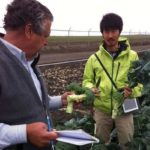Getting to Know Sakata Seed America
Our R & D department makes certain that varieties meet market requirements and exceed customer expectations.
Keeping promises is an important part of maintaining your trust. At Sakata Seed America, we want our products to deliver as promised. We invest a lot of time and money in creating new varieties that will perform well year after year. Developing a new product requires patience and perseverance; the entire process from start to finish can span as much as fifteen years. Our research and development department makes certain that our finished products meet market requirements and exceed customers’ expectations.
Broccoli breeder Akira Nishi in the Salinas field discussing broccoli varieties. Researcher Nihat Guner specializes in watermelon breeding for the world market. He is based at our Florida research station in Ft. Myers. Assistant Breeder Jenna Price working with cabbage plants. The research and development team utilizes state-of-the-art technology and conventional plant breeding techniques to breed new varieties with high performance. Researchers consider market requirements and geographical location when deciding which plants to select. Other factors such as yield potential, disease resistance, flavor, shelf life and stress tolerance also play a role in the decision. Yield and disease resistance are two of the most important because it is difficult for the products to be competitive without these qualities. According to Jeff Zischke, Director of Research for Sakata Seed America, it is tough to introduce a new product to the market without the foundations of yield potential and disease resistance. “The flavor can be terrific and the appearance beautiful, but the product won’t make it unless it can turn a profit for the grower,” says Zischke.
Research Challenges
Carrying out research and development work is not without its challenges. “Flavor analysis, in tomatoes for instance, is especially difficult because flavor is complex and opinions vary,” explains Zischke. Selecting for flavor is difficult as tomatoes can vary when picked from the same plant and differences in cultural practices and weather from generation to generation can also affect flavor. Another challenge is finding products that adapt to different markets and growing conditions. Zischke explains that the company is always interested in finding widely adapted products with multiple markets for the seed because it is resource intensive to maintain inbred lines and hybrid seeds for too many products at one time.
Deciding when new varieties are ready for the market is another difficult aspect of research and development. The decision carries a lot of responsibility because of the importance of ensuring that the seed will perform for growers. Liability and loss of credibility are also important considerations. “You want to test a variety enough to make sure there isn’t a risk, but then you are not fast enough to be competitive,” Zischke says. “You are always walking a fine line between the two.” This is a challenge that the team faces on a regular basis. They have to determine if they have enough information to move forward and at what level.
Trialing and Testing
Data collected from trialing and testing helps researchers decide which plants to develop further and which ones to eliminate from their shortlist. This process involves a large amount of people as researchers, breeders, growers, dealers and product managers all assist with trialing new varieties. Researchers collect and evaluate data from multiple trials and seasons before they make decisions about which products to advance.
New varieties that make it to the commercial market are truly exceptional products thanks to the research and development team’s hard work. With their help, Sakata’s new introductions are not only flavorful, beautiful and healthy—they deliver as promised.
The Right Tools and Talent Make all the Difference
Jeff Zischke, our director of research, draws upon 22 years of experience to manage the research and development department. He worked as a tomato breeder and global product manager prior to becoming the research director.
Zischke’s experiences make him cognizant of the fact that breeders need the right tools to do their jobs. “I am a proponent of putting more technology at the disposal of our breeders,” Zischke says. “Technology that supports the conventional breeding approach is becoming more and more necessary to stay competitive.”
Despite the available technology, Zischke feels that the success of his department is really due to the dedicated people within it. “Our staff members are very talented and are passionate about what they do. They have invested their careers in Sakata and we continue to reap the rewards of that,” says Zischke.
